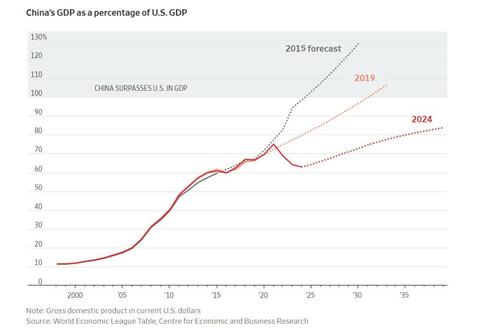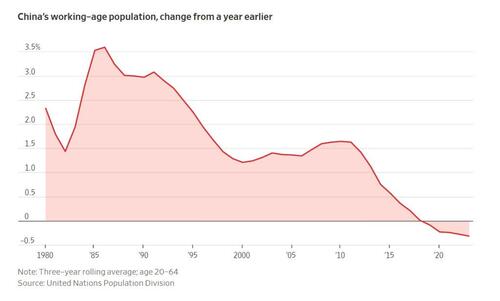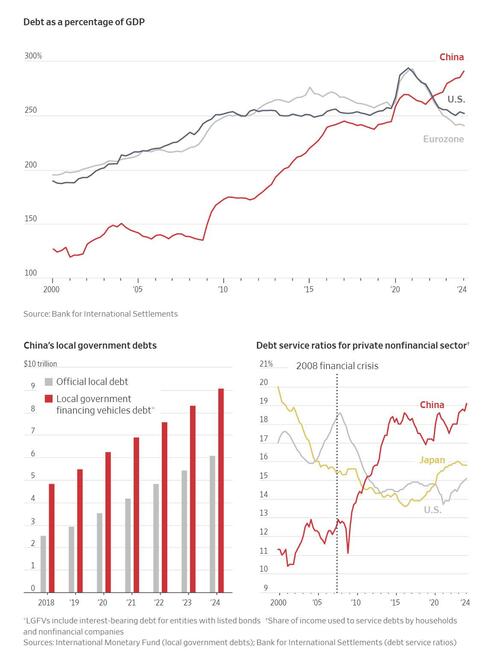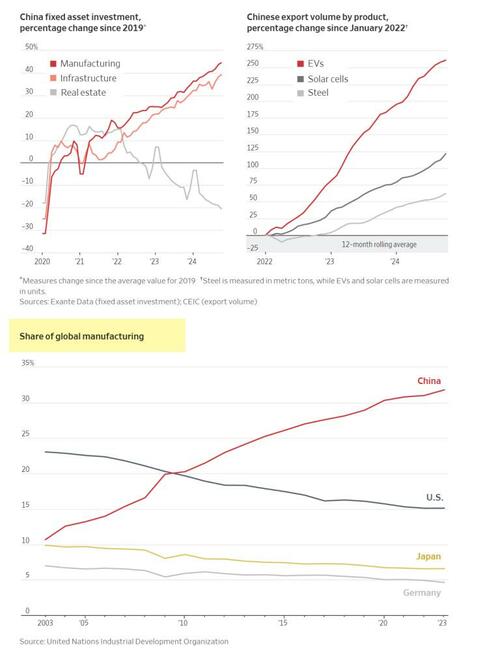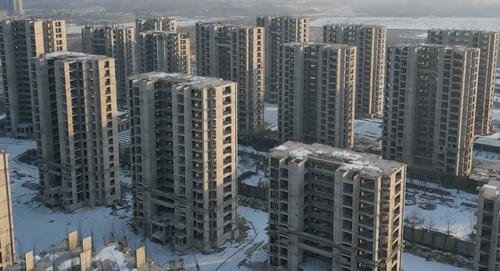Years Of Repeat Central Planning Mistakes Have Doomed China’s Economy
Authored by Mike Shedlock via MishTalk.com,
Other than exports, no country wants to be like China.
China Overindebtedness, Overbuilding and Overcapacity
The Wall Street Journal reports China’s Economy Is Burdened by Years of Excess. Here’s How Bad It Really Is.
Destiny deferred
China’s rapid growth meant that for years forecasters expected China to overtake the U.S. as the world’s largest economy. As recently as 2019, some forecasters were expecting China’s GDP to eclipse the U.S.’s around 2030. Today, it is the U.S. powering the global economy and China that is battling stumbling growth. Few now expect China to catch up with the U.S. before midcentury, if it manages to at all.
Ticking time bomb
China is also facing demographic headwinds that will make it harder to restore its economic vigor. China’s working-age population is shrinking, reversing the demographic dividend that powered its economic ascent.
China’s Working-Age Population
China’s economy has for decades been powered by heady levels of investment. At first, that yielded modern infrastructure and propelled the expansion of China’s manufacturing engine and its megacities. But sticking with that strategy year after year has meant China today is beset by colossal debts, unneeded apartments and industrial overcapacity.
Debt as Percentage of GDP China
Debt: Borrowing by government, households and corporations in China is approaching 300% of its annual GDP. “Hidden” borrowing by local governments—debt held off the books on their behalf by opaque investment companies known as local government financing vehicles—is a major problem. On some measures, the scale of those debts and the burden of servicing them in China is more severe than in the U.S. before the financial crisis or in Europe in the depths of its own debt crisis a decade ago.
Real estate: China’s real-estate boom was unprecedented—and so is the ongoing bust. New construction and sales have cratered since the government took steps to rein in the bubble in 2020. It has struggled to stabilize the market, despite measures to ease purchase restrictions and offer cheap credit to would-be buyers.
One sign of the boom’s excesses: There are as many as around 80 million vacant units in China, according to the latest estimates at the end of November, equivalent to half the total housing stock of the entire U.S.
Share of Global Manufacturing
Industrial Overcapacity
In response to the slowing economy, and to transform China into a technological colossus, leader Xi Jinping has been funneling investment into China’s already huge factory sector. The result has been a surge in industrial capacity and two years of falling prices for Chinese producers, which are increasingly looking overseas to find buyers for goods they can’t sell at home. That is sparking trade spats with the U.S.-led West and emerging markets such as Brazil and India.
Debt Deflation Trap
China is in a debt deflation trap of its own making.
It makes sense to add capacity if the debt is productive and can be serviced.
China should write down debts but much of that is in State Owned Enterprises (SOE), and the political class will not take a hit or admit mistakes (just like everywhere else).
Mirage of Growth
Image WSJ
For decades, China depended on property bubbles for growth. With building now crumbling, all of that growth was a mirage.
I have been writing about China’s “ghost cities” where no one lives for a decade. They are a result of malinvestment.
Building those cities added to GDP, but it was really 100 percent waste.
World’s Biggest Property Bubble
On March 23, 2011 I noted World’s Biggest Property Bubble: China’s Ghost Cities Revisited; 64 Million Vacant Properties
The true state of affairs is China’s banks are insolvent. China is building units for which there is little demand and few can afford. China will have to print money to pay for all of this malinvestment. The idea the Yuan is undervalued fails to take into consideration any of this.
Bonds of China’s Largest Property Developer Crash
On August 10, 2023, I noted Bonds of China’s Largest Property Developer Crash to 25 Percent of Notional Value
Hello there Purchasing Power Parity (PPP) GDP advocates and China horn tooters in general, let’s discuss real estate.
It was a long time waiting for the inevitable.
Flashback Hoot of the Day: When Will China Overtake the US?
On August 6, 2023 In Flashback Hoot of the Day: When Will China Overtake the US? I discussed a bet that Michael Pettis made with the Economist on when China would pass the US in GDP.
The Economist made a bet with Pettis in 2012 that by 2018 China would pass the US. The Economist lost the bet by a mile. China is still not close to the US in GDP. A couple of my readers say not so, based on PPP.
Fundamentally, PPP is horrendously flawed.
Purchasing Power Parity Silliness and the Myth China Passed the US in GDP
On August 8, 2023, I discussed Purchasing Power Parity Silliness and the Myth China Passed the US in GDP
Some of my readers claim China passed the US in GDP based on Purchasing Power Parity (PPP). The rationale is hugely flawed.
Michael Pettis: “Adjusting GDP for differences in purchasing power makes a great deal of sense in certain cases, but the way it is done is so filled with problems that it is extremely difficult to find any economist who takes these measures very seriously.“
What I Said in 2011
All this talk about how undervalued the Yuan is, how China will rule the world, and why the Yuan will be the next global reserve currency is pure silliness.
China’s growth is nothing more than a credit bubble on steroids. Cities are vacant, yet China keeps building, and building and building.
Savings Glut Thesis
There is still rampant belief that China is this big nation of savers, and US trade deficits are the other side of the coin.
Ben Bernanke, Larry Summers, and even Michael Pettis believe in the savings glut thesis. It is my one ongoing disagreement with Pettis.
But Pettis is slightly different in that he calls it a savings imbalance. I still disagree, but “imbalance” is closer.
I highly respect Michael Pettis, he taught me nearly everything I know about trade.
Here’s my question: China now has a debt to GDP ratio of nearly 300 percent. So where the heck is the saving either in China or here?
We can look at M2 or money supply and the massive wealth of people like Elon Musk, but printing money (yaun or dollars) is not savings.
What is Saving?
Saving is production minus consumption. China’s property bubble is a great example.
People alleged “saved” their money by investing in property bubbles. But entire cities are now worthless. China needs to spend money to tear them down.
That savings has been rendered worthless, but the debt remains, and the cities are now of negative value (they need to be torn down).
That China made a few billionaires in the process is not a savings glut, not a savings imbalance, and not net savings.
Ghost cities do not constitute savings. They do constitute savings destroyed. And the process is still ongoing.
Hoot of the Day
People are still predicting the demise of the US and destruction of the US dollar. Nonsensical US hyperinflation talk has been ongoing the whole time.
China is a manufacturing miracle but all China did was replace a property bubble with an even bigger manufacturing bubble to keep people employed.
We are now at a point where China is subsidizing exports to an extent the world has never before seen, just to keep it’s economy growing (on paper).
This is a better use for “saving” than property bubbles that have been more than 100 percent wiped out (again think of cleanup costs), but the return on these manufacturing investments is less than zero.
Who’s Paying the Price?
Chinese consumers paid the price of now less than worthless property bubbles.
Chinese consumers continue to pay the price of subsidizing exports.
China desperately needs a course correction but there are no signs China is about to do so.
So, What Country Wants to Be Like Germany Now?
On December 17, 2024, I asked So, What Country Wants to Be Like Germany Now?
The collapse of Germany shocks many. But I have been discussing why this was inevitable for over a decade.
The current chancellor has called for bailouts and subsidies to save jobs and prop up struggling carmakers, while Merz has floated a menu of supply-side measures such as lower taxes, less bureaucracy and steps that would make it cheaper for businesses to reach Berlin’s climate goals.
Shocked? I’m Not
This is all so predictable. The only thing debatably shocking is how it too so long.
Flashback April 11, 2013: Eurozone Math; One Size Fits Germany; Door Number Two
As a direct result of the unstable eurozone treaty, sovereign interest rate imbalances, Target II imbalance, and trade imbalances are out of control. Germany and the other European creditor countries are owed money that cannot be paid back.
Few have made the connection, but Germany and China are both following in the footsteps of Japan’s debt deflation trap.
Price deflation is a benefit. Debt deflation and writeoffs of debt are a curse.
We are in this mess because Central banks and governments fail to differentiate. Don’t be like central banks and confuse the two.
Tyler Durden Fri, 01/03/2025 – 07:45
Source: https://freedombunker.com/2025/01/03/years-of-repeat-central-planning-mistakes-have-doomed-chinas-economy/
Anyone can join.
Anyone can contribute.
Anyone can become informed about their world.
"United We Stand" Click Here To Create Your Personal Citizen Journalist Account Today, Be Sure To Invite Your Friends.
Before It’s News® is a community of individuals who report on what’s going on around them, from all around the world. Anyone can join. Anyone can contribute. Anyone can become informed about their world. "United We Stand" Click Here To Create Your Personal Citizen Journalist Account Today, Be Sure To Invite Your Friends.
LION'S MANE PRODUCT
Try Our Lion’s Mane WHOLE MIND Nootropic Blend 60 Capsules
Mushrooms are having a moment. One fabulous fungus in particular, lion’s mane, may help improve memory, depression and anxiety symptoms. They are also an excellent source of nutrients that show promise as a therapy for dementia, and other neurodegenerative diseases. If you’re living with anxiety or depression, you may be curious about all the therapy options out there — including the natural ones.Our Lion’s Mane WHOLE MIND Nootropic Blend has been formulated to utilize the potency of Lion’s mane but also include the benefits of four other Highly Beneficial Mushrooms. Synergistically, they work together to Build your health through improving cognitive function and immunity regardless of your age. Our Nootropic not only improves your Cognitive Function and Activates your Immune System, but it benefits growth of Essential Gut Flora, further enhancing your Vitality.
Our Formula includes: Lion’s Mane Mushrooms which Increase Brain Power through nerve growth, lessen anxiety, reduce depression, and improve concentration. Its an excellent adaptogen, promotes sleep and improves immunity. Shiitake Mushrooms which Fight cancer cells and infectious disease, boost the immune system, promotes brain function, and serves as a source of B vitamins. Maitake Mushrooms which regulate blood sugar levels of diabetics, reduce hypertension and boosts the immune system. Reishi Mushrooms which Fight inflammation, liver disease, fatigue, tumor growth and cancer. They Improve skin disorders and soothes digestive problems, stomach ulcers and leaky gut syndrome. Chaga Mushrooms which have anti-aging effects, boost immune function, improve stamina and athletic performance, even act as a natural aphrodisiac, fighting diabetes and improving liver function. Try Our Lion’s Mane WHOLE MIND Nootropic Blend 60 Capsules Today. Be 100% Satisfied or Receive a Full Money Back Guarantee. Order Yours Today by Following This Link.




